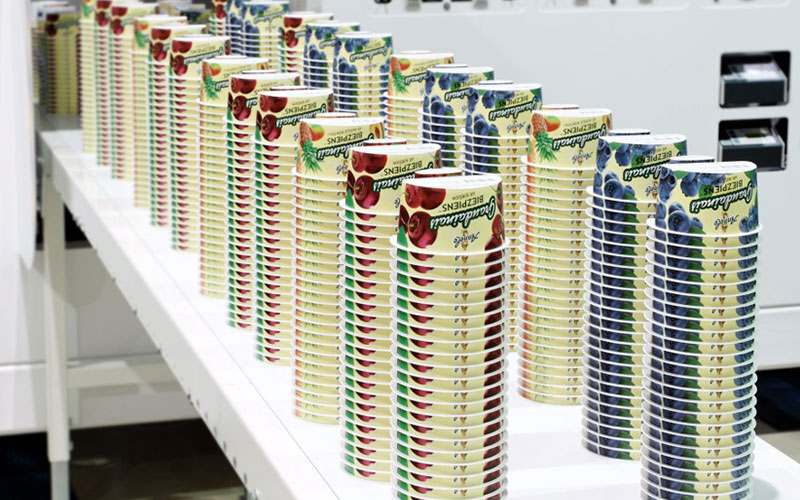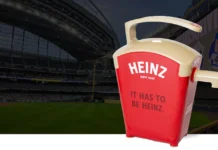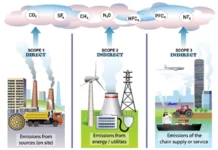by Liz Stevens, writer, Plastics Decorating
Automation is a key to the future for all types of manufacturing processes. Decorating options for molded plastic parts are no exception. This is especially important for molders who are involved with or are considering in-mold decorating and labeling, where automation and robotics are essential as an element of the success of the process. This article will discuss where automation fits in for in-mold processes, the manufacturing setups for which it is best suited, advice for successful integration, where in-mold decorating and in-mold labeling fit with sustainability initiatives, and intel on emerging trends and observations about forward-thinking developments in the industry.
Plastics Decorating asked questions to three experts to obtain their perspective on these subjects. These included Ryan Workman, Muller Technology Co., Inc., Fort Collins, Colorado, a product development, automation technology and tool maker for thin-wall plastic packaging; Mike Sansoucy, ARBURG, Rocky Hill, Connecticut, an injection molding machine manufacturer; and Jim Naatz, Sussex IM, a plastics injection molder and in-mold decorating/labeling operation in Sussex, Wisconsin.
When is it best to use IMD/IML automation?
Ryan Workman, Muller Technology Co., Inc., said that several factors make for the best use of IML automation: “The best application for IML automation usually is very high volume, millions of parts per year.” Many times, the automation and robotics needed for IMD/IML would likely be overkill for a low-volume manufacturing line. Workman went on to say that automation fits well with critically precise label placement. “Automation is great for clients who want their labels to be just perfect,” Workman said, “so that their shelf presence stands out from the competitors and so that product quality is extremely consistent.”
A large-sized product with a large label, as opposed to a large volume of production, may be incompatible with IML automation. “For items like industrial pails,” said Workman, “the labels can be huge. At a certain point, the labels can be so large that you can’t even load them into the machine. You can’t really deploy automation at that point.”
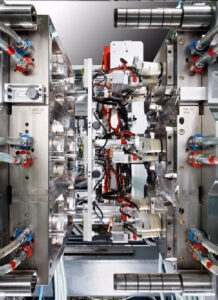
Sussex IM’s Jim Naatz echoed points made by Workman. “One of the first things that we always take into consideration is the volume,” said Naatz. “What number of parts are you going to be looking at on a yearly basis – the EAU, or estimated annual usage?” Naatz explained that EAU drives cavitation, and cavitation drives the whole process. He also suggested reviewing post-molding operations, such as assembly after molding or after decoration, or whether there are inserts to be installed. “Is there any gating, any trimming?” Naatz continued. “You definitely want to ask that upfront. And what type of customization, what type of flexibility is required?”
Naatz pointed to multiple SKUs, multiple sizes of a product and multiple molds in an interchangeable IML system as production elements that must be in sync with automation. “At Sussex,” he said, “we always are moving equipment around as a custom molder. You really want to understand up front how many SKUs you are going to be working with – how many different decorations you are going to be working with – so that the automation supplier can offer flexibility and work with you around all of that.”
ARBURG’s Mike Sansoucy offered advice born of experience installing injection molding machines and seeing installation fiascos. “It can go sideways if you don’t think it through,” he said. “If you are going to get into IML automation, you have to look at the system holistically.” He advised against viewing the integration of automation as a standalone project or only from the standpoint of the automation itself. Instead, he said, “the way to be successful, especially if you are just getting into it, is to look at the big picture.” He suggested including a turnkey partner – the machine or robot supplier or even another integrator that can look at the whole proposed automation project and point out any problems or snafus that might crop up.
Sansoucy related the story of a molder that got into IML the wrong way, with a bad outcome. The molder got a big contract with a food company to produce lids for cups. The molder had failed to take the IML aspect into account when the mold gating was designed. “When you do IML, you need to reverse gate it so you can get the gate behind the label,” he explained, “They ended up with a hole right in the center in the beautiful label design of the lid from the gating.” Sansoucy was called in to recommend a fix. His assessment: “The project needed a new mold.” The label production ended up going from IML to pressure sensitive, with eight to 10 people peeling and sticking labels. “Like I said, it can go sideways if you don’t think it through,” said Sansoucy.
What should molders keep in mind when considering automation?
“There are several things that we look at when an application comes to us for evaluation,” said Workman. “Part shape matters. It is important to make sure that the part and the mold are conducive to automated IML production. Label shape matters, too. Some label shapes require special technologies to place the labels correctly.” Workman said that the number of labels per part also is a factor. “For applying labels outside of the cavity,” he said, “the number of labels can be a limiting factor. One label per part from a multi-cavity mold may be okay, but if you go to two labels per part, now you’ll have many more labels to handle.” Workman noted that special requirements along the production line, such as an inspection stage and the finished product handling stage, must be considered and the space for them must be designed into an automated line.
Where is the growth in the application of in-mold labeling or with particular products or industries?
Workman noted an area of growth based on his experience with Muller Technology. “In the past, with thin-wall molded container applications, the way to go was to mold and then to print the containers with a secondary printing/decorating process that ran huge volumes. But that requires storing the containers between production steps. You couldn’t print right after molding, and ground containers and industrial pails, especially, could get stuck on the printing equipment if they were put in while still hot.”
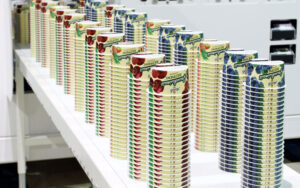
Workman explained that IML allows operators to take the molded/labeled product directly off the line and ship to the customer without storage, and eliminates some secondary processes. He admitted that it still is challenging to deal with large-volume applications but said that IML now is going to higher and higher cavitations.
“What we are seeing at Sussex,” said Naatz, “is more engineered resins. More people are coming to us with resins that can be extremely challenging and very hard to push, but they are beautiful.” Customers are asking for more complexity, more pre-forms and corner wraps. Naatz also is seeing changes in how labels are used in food service, branching far beyond just containing information like nutrition and ingredients.
Sansoucy also has seen labels undergoing big changes. Compared to 10 or 15 years ago, when the only people doing IML were major brand owners, Sansoucy said that brands of all sizes are considering IML due to the continued push for brand owners to differentiate their products. “On the packaging side, what is growing is the use of smart labels – functional labels with QR codes. Scan the code with your phone and a little video comes up, for example, showing how to recycle the product.” He cited the popularity of the circular economy concept and the HolyGrail 2.0 program, which take a product’s end-of-life stage into account.
Speaking of re-use, recycling and sustainability, where does IML fit in?
Naatz, whose company works extensively with the cosmetics industry, said that sustainability and recycling come up constantly. “Sustainability is at the forefront of every conversation now,” he said. “With some of the decoration technology that we do, we are just putting paper labels on products that are one-use items.”
Naatz pointed out that in looking at a polypropylene single-use product, the question becomes how can one switch from a paper label that is pressure-sensitive for use with a label applicator to labeling instead with IML? “There are a lot of challenges with that,” he said, “both with the polypropylene substrate and a polypropylene label used with IML, but it would be great from a recycling standpoint.” The challenge, he said, is that the job uses a 16-cavity tool where each part gets two labels. “The idea of automation for that and the challenges of placement open up a lot of other potential issues. But it is definitely being looked at really hard right now for single-use plastics.”
Sansoucy, too, is fielding questions about these topics from customers who often push back against IML as not being sustainable. “There is a belief that all paper is sustainable, especially compared to IML. It is a challenge to help customers understand that if we use pressure-sensitive paper labels – with a release liner – there are recycling challenges with it.”
Workman said that some molders are mixing paper and plastics, “so that your traditional polypropylene label now is a paperboard label, kind of like ice cream lids, but this is actually a whole container. We make the container with the paperboard as a structure.”
He noted that this does not make for a recyclable item but it does represent a significant reduction in the amount of plastic used. “That has been a big avenue, and it has grown a lot in the last couple of years.”
How will “extended producer responsibility” affect IML and IMD moving forward?
Extended Producer Responsibility (EPR) is a policy approach under which producers are given a significant responsibility – financial and/or physical – for the treatment or disposal of post-consumer products.2 EPR is gaining popularity in the United States “with 40 such laws enacted since 2008 – in 2010 alone, 38 such EPR bills were introduced in state legislatures across the United States, and 12 were signed into law.”3 However, these laws are only at the state level as there are no federal laws for EPR.
Sansoucy stated that EPR is a huge topic in the industry. “States are saying, ‘Look, you are making money (meaning large brand owners), and you need to pony up resources to take that plastic back.’ ”
One of the challenges so far has been getting enough material returned to manufacturers to make the initiative financially viable. Sansoucy related that Ice River Green Bottle Company4, in Ontario, Canada, has managed to scale up the return of its bottles by setting up drop areas.
“Ice River takes all the bottles back and re-uses them, taking the bottle caps and recycling them to make extremely high-end outdoor furniture. Ice River created a whole business model around that by working with the government in Ontario.”
Naatz pointed to a US-based example of extended producer responsibility – a collaboration between SC Johnson and Milwaukee Brewers’ American Family Field5. “There is a recycling program at the Field,” said Naatz, “where the game crowd returns the empty plastic beer cups to a special receptacle. SC Johnson then upcycles the plastic into packaging for its products. It looks like this is going to be a great program. Companies definitely are feeling the sustainability push, and they are trying to find better ways to recycle this plastic back into their products.”
What are some of the growing markets for IMD/IML now and into the future?
Sansoucy pointed to cannabis as a sector in which IML and sustainability will be big. “Cannabis is a huge market,” he said. “It is perfect for IML because it is a premium product – people are going to pay a higher price, which supports the cost for IML – and the buyers want a functional package, too.” He also pointed out that barrier packaging with labels for both cannabis and medical is a big, untapped market.
Naatz commented further on the medical market. “I think it is the most interesting, especially for IML,” he said. “Especially with the interactive things that you could potentially do with IML.”
As Sansoucy touched on when he mentioned barrier packaging, there is security, scanning and traceability; you can do all that with digital IML.” Naatz sees this as a game changer. “The medical industry still is caught up with COVID-19 and focusing on the health of individuals,” he said, “but I think that what is going to come out of this pandemic is a lot of really great technology for use with IML.”
In Workman’s estimation, food packaging and housewares likely will be among the next to adopt IML. These product lines may not be leaders in high volume, but they do offer items with a margin high enough to justify the cost of turnkey IML automation.
This article was based on a panel presentation – “Automation & Robotics for IMD-IML and other Decorating Processes,” – which was part of the recent 2021 In-Mold Decorating Association Symposium and SPE Decorating & Coatings Division TopCon, held September 16-17 in Edina, Minnesota.
References
- HolyGrail 2.0, AIM® European Brands Association, www.digitalwatermarks.eu.
- Extended producer responsibility – OECD, https://www.oecd.org.
- Nash, Jennifer, and Christopher Bosso. “Extended Producer Responsibility in the United States.” Journal of Industrial Ecology 17.2 (2013): 175-85. Web.
- Ice River Green Bottle Co., www.icerivergreenbottleco.com.
- “Home Run! SC Johnson and Milwaukee Brewers Partnership is a Win for the Planet,” 20 Apr 2021, www.scjohnson.com/en/stories/sustainable-world/plastic-reuse-and-recycling/2021/april/home-run-sc-johnson-and-milwaukee-brewers-partnership-is-a-win-for-the-planet.

